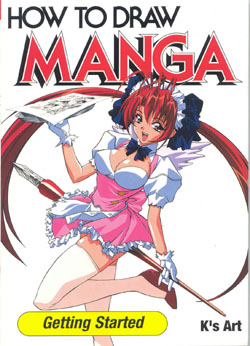Wondering, “WHAT SHALL I GET HIM FOR CHRISTMAS?”

By K’s Art (Graphic-Sha)
ISBN 10: 1-59396-066-2 ISBN 13: 978-1-59396-066-7
With the popularity of Manga and Anime seemingly unquenchable it might be worthwhile to take a look at the one of the many reference volumes available to the would-be exponent of the Japanese method of comic making.
Getting Started is the first in a long series of books that includes specialised editions covering Maids, Giant Robots, Tone Techniques, Colourful Costumes, Girl’s Life, Guns & Military and Super-Deformed Characters amongst others. It is pretty much the equivalent of a comic strip foundation course, and in many ways it follows the tried and true western publishing format and ideology, although there are a few noticeable – one might say philosophical – differences.
Sub-titled ‘Basic Tools, Tips and Techniques for Aspiring Artists’ there is a heavy emphasis on using the right technology for creating pictures on paper, with great attention paid to which paper, pencils, erasers, pens, markers, rulers, and such paraphernalia. This stressing of the right tool is sensible and correct but I am unsure if this is purely the cultural ethic of a meticulous craft industry, or if it has something to do with the fact that the publishers run an internet Manga art-supplies company. As any artist will attest, we’re all suckers with hungry eyes when it comes to a new, sleek and shiny piece of kit.
Chapter 1 tells in great (some might say excruciating) detail everything anyone could possibly ask regarding not just pens and papers, but even how to recondition nibs and how to blot ink and apply corrective fluid. Chapter 2 deals in the same manner with the creation of characters. This includes Desirable Manga Proportions, Balancing a Frame or a Page, Drawing Heads, and How to use a Mirror.
Everything you need to know about applying those signature Tones and patterns is the topic of chapter 3 followed by a meticulous description of the Japanese way to tell a comic story – featuring Proposal Drafts, Frame Allotment Theory, Transferring Proposal Drafts to the Manga Page, How to Prepare Large Frames and How to Draw Frame Borders, Dialogue Balloons and even Flashes – those spiky circles of lines used to denote strong emotion. Chapter 5 reveals all the secrets behind the creation of backgrounds including a thorough examination of various point perspectives. Each chapter is concluded with a Question and Answer section.
In most ways this is a thorough and informative package, although it should be remembered that some of the tools and materials may not be available in your local art-shop, or may be called by another name. Also worth stressing is that even in Japan the concept of a “right†and “wrong†way to do Manga is just a value judgement, and one that is constantly ignored. All over the planet, the true maxim is, “as long as it can actually be reproduced, whatever works, worksâ€.
Also, the book does seem to be addressing two completely disparate levels of accomplishment, with mind-numbing, patronising simplicity of tone and address side-by-side with passages of extreme complexity. Perhaps there is a more formalised approach to art education at work than we’re used to in the free-wheeling West. On a more personal note, I found the chatty folksiness a little off-putting, and got very tired, very quickly, of the cute talking animals ad-libbing on most pages. Still I’m not the one the book is aimed at, am I?
© 1997 K’s Art. ©1997 Graphic-Sha Publishing Co, Ltd. All Rights Reserved.

One Reply to “How to Draw Manga 1: Getting Started”
Comments are closed.